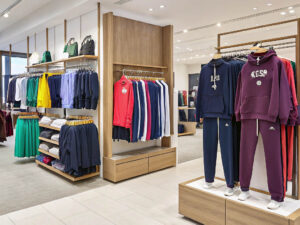Campus activewear is a growing niche in the apparel industry, targeting students and university communities. But is it a profitable business? With rising demand for athleisure and branded merchandise, many entrepreneurs and brands are exploring this market.
Yes, campus activewear can be highly profitable due to strong brand loyalty, consistent demand, and the athleisure trend1. However, success depends on quality, pricing, and effective marketing strategies.
The profitability of campus activewear depends on various factors, from production costs to marketing and distribution. Let’s explore what makes this market a viable opportunity.

Why is campus activewear a growing market?
The activewear market has expanded beyond gym-goers to include students and everyday wearers.
Students prioritize comfort and style, making activewear a staple for campus life. Branded university apparel also creates a sense of belonging, driving demand.
Factors Driving Campus Activewear Growth
- Athleisure Trend – Students prefer versatile clothing that transitions from class to workouts.
- University Branding – Schools and sports teams boost demand for customized activewear.
- E-commerce Growth – Online shopping makes it easier for students to access branded gear.
- Sponsorship & Merchandise Deals – Universities collaborate with brands for exclusive apparel lines.
With increasing student populations and lifestyle changes, campus activewear remains a strong business opportunity.
How profitable is the campus activewear industry?
The profitability of campus activewear depends on production costs, pricing strategies, and brand positioning.
Campus activewear can generate high profit margins, especially with premium branding and exclusive designs. Bulk production and direct-to-consumer sales improve profitability.

Profitability Breakdown
| Factor | Impact on Profitability |
|---|---|
| Production Costs | Lower costs improve margins but must maintain quality. |
| Pricing Strategy | Premium pricing boosts profits but requires strong branding. |
| Brand Recognition | Exclusive campus partnerships drive sales. |
| Sales Channels | Direct sales (e.g., online stores) increase profit margins compared to third-party retailers. |
Selling directly to students through university stores, pop-up shops, and e-commerce can significantly boost revenue.
What are the challenges of running a campus activewear business?
Despite its profitability, the campus activewear industry comes with challenges.
Competition, licensing fees, and changing fashion trends can impact sales and profitability.
Common Challenges in Campus Activewear
- High Competition – Major brands like Nike and Adidas dominate the market.
- Licensing Fees – University-branded merchandise often requires licensing agreements.
- Seasonal Demand – Sales may fluctuate based on school events and athletic seasons.
- Fast Fashion Pressure – Keeping up with trends requires quick design updates.
Overcoming these challenges requires a strong brand identity, efficient supply chains, and targeted marketing strategies.

How do top brands make campus activewear successful?
Major sportswear brands have mastered the art of selling activewear on college campuses.
Brands like Nike, Lululemon, and Under Armour use athlete sponsorships, exclusive campus stores, and social media to dominate the market.
Key Strategies of Leading Campus Activewear Brands
| Strategy | Example |
|---|---|
| University Partnerships | Nike collaborates with college sports teams for branded apparel. |
| Influencer Marketing | Lululemon targets student ambassadors2 to promote products. |
| Limited Edition Drops | Adidas releases special collections for major universities. |
| Online & In-Store Sales | Under Armour sells through campus stores and online platforms. |
Emerging brands can adopt similar tactics on a smaller scale by focusing on niche markets or local universities.
What are the best marketing strategies for campus activewear?
A successful campus activewear brand needs strong marketing to build brand loyalty and drive sales.
Social media, student ambassadors, and campus events are key to engaging the target audience.
Effective Campus Activewear Marketing Strategies
- Student Ambassadors – Recruiting students to promote the brand on social media.
- Exclusive Campus Deals – Offering discounts for students and faculty members.
- Sponsoring University Events – Gaining brand exposure through sports teams and clubs.
- E-commerce & Social Commerce – Selling directly through Instagram, TikTok, and online stores.
Combining digital and offline marketing helps brands connect with students where they are most active.
Is it better to manufacture or dropship campus activewear?
Choosing between manufacturing and dropshipping depends on budget and scalability.
Manufacturing offers higher profit margins and customization, while dropshipping reduces upfront costs but has lower control over quality.
Pros & Cons of Manufacturing vs. Dropshipping
| Model | Pros | Cons |
|---|---|---|
| Manufacturing | Higher profits, better branding | Higher investment, inventory risks |
| Dropshipping | Lower startup costs, easy to scale | Lower profit margins, less control over quality |
Brands looking for long-term growth should consider manufacturing, while startups can test the market through dropshipping before committing to production.
Conclusion
Campus activewear is a profitable market with strong demand from students, athletes, and university communities. Success depends on branding, pricing, and marketing strategies. While competition is high, businesses that leverage social media, student engagement, and university partnerships can build a thriving brand. Whether through manufacturing or dropshipping, campus activewear remains a lucrative industry for entrepreneurs willing to innovate and adapt.













